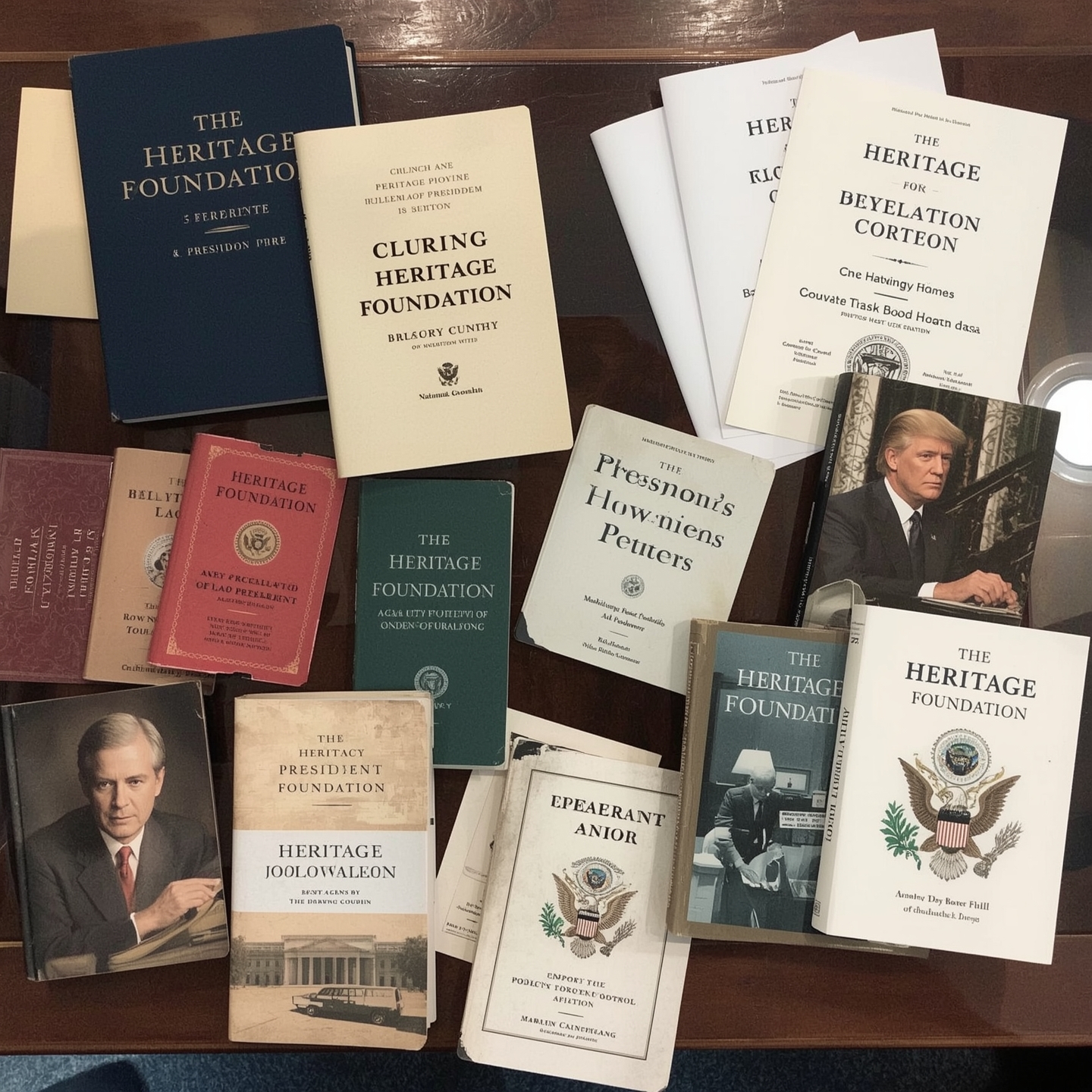
American Executive Leadership: How the Heritage Foundation Helped Redefine the White House
Custom HTML/CSS/JAVASCRIPT“The most significant revolutions in American executive power haven’t happened in the public eye—they’ve happened in binders and briefing books, crafted long before a president takes the oath. The Heritage Foundation reminded us that leadership can be quietly written, then boldly enacted.”
American Executive Leadership: How the Heritage Foundation Helped Redefine the White House
1 Introduction: Power Shifts in the People’s House
2 The Early Oval Office: From Founders to FDR
3 The Rise of Modern Executive Power
4 Think Tanks and the Age of Playbooks: Enter the Heritage Foundation
5 Modern Shifts: The Policy Machine, Project 2025 & H.R.1
Key Influences Visible in Modern Policy:
6 Project Esther: Redefining the Battle Lines of American Politics
A New Front in Executive Strategy
How Does This Connect to Project 2025?
Watch: Project Esther & Project 2025 Explained
7 The Human Side: Controversy, Vision, and the Everyday Citizen
8 Conclusion: Shaping the Future, One Plan at a Time
Reflection & Action Guide: Effective, Lawful, and Respectful Leadership
1 Introduction: Power Shifts in the People’s House
America’s presidents aren’t just politicians or figureheads—they’re storytellers, change-makers, and, sometimes, disruptors. Over the decades, the very nature of leadership at the top has changed. Behind many of those shifts, you’ll find think tanks hard at work—including the influential Heritage Foundation. In this post, we’ll walk through the evolving styles of executive leadership in the United States, spotlight major moments when “the rules” seemed to change, and reveal how the Heritage Foundation helped steer the ship.

2 The Early Oval Office: From Founders to FDR
Early presidents were guided by the original vision of limited executive power, designed to balance Congress and avoid monarchy. Leadership was often reactive—managing crises, wars, and expansions as they came.
3 The Rise of Modern Executive Power
With Franklin Roosevelt (FDR), executive leadership took on a new, more activist role. FDR’s New Deal and World War II leadership expanded presidential powers and government influence. From there, presidents increasingly shaped the country through sweeping policies, think Kennedy’s New Frontier or Reagan’s economic crusades.
Key Moments & Lessons
FDR’s New Deal: Birth of the modern regulatory state
Truman-Eisenhower-Kennedy: Cold War and the president as a global operator
Nixon-Reagan: Executive action as a policy tool—sometimes for good, sometimes for controversy
4 Think Tanks and the Age of Playbooks: Enter the Heritage Foundation
The story changes dramatically with the rise of policy “playbooks.” The Heritage Foundation, founded in 1973, wasn’t just another think tank—they meant business. Their guides, like the renowned “Mandate for Leadership,” put actual policy blueprints into the hands of incoming presidents.
The Heritage Playbook Era
1981: Heritage’s “Mandate for Leadership” helps shape Reagan’s agenda. About 60% of their suggestions are implemented.
Ongoing: Heritage continues to release “Mandate” editions, influencing administrations from Reagan through Trump.
Today: The organization’s influence is seen in the personnel, priorities, and approaches proposed for executive leadership.
5 Modern Shifts: The Policy Machine, Project 2025 & H.R.1

In recent years, executive leadership has become even more programmatic—with incoming presidents arriving armed with detailed, step-by-step plans. The Heritage Foundation’s latest “Project 2025” is a mega-blueprint driven by their decades of experience.
Meanwhile, major legislation like H.R.1 - The One Big Beautiful Bill Act and committee reports from the 119th Congress reflect how execs are guided by—and help drive—the priorities of these foundational playbooks. These documents cover everything from defense spending and energy to tax reform and public education, echoing Heritage’s longstanding priorities.
Key Influences Visible in Modern Policy:
Consolidation of Executive Power: Push for a “unitary executive” (more presidential control)
Reforms Across the Board: Education, tax, social security, environmental rollbacks—all with Heritage fingerprints
Personnel as Policy: An emphasis on hand-picking executive branch staff using talent pools aligned with specific policy goals
6 Project Esther: Redefining the Battle Lines of American Politics
A New Front in Executive Strategy
Project Esther is one of the latest—and most controversial—policy frameworks to emerge from the Heritage Foundation, a think tank known for mapping out conservative action plans for American governance. Released in late 2024, Project Esther brands itself as “A National Strategy to Combat Antisemitism.” But its ambitions and implications run much deeper, reshaping the way the American executive might use its power in the years ahead.
What Is Project Esther?
Born out of the Heritage Foundation's desire to wield government as a proactive cultural force, the project calls for a sweeping, government-backed campaign to identify, target, and disrupt what it labels as the “Hamas Support Network” in America. Its narrative links pro-Palestinian and progressive campus movements to national security threats, recommending that these entities be subject to potential legal action, defunding, deportation, or exclusion from public institutions.
Key Features:
Expansive Definition of Threats: The project includes not only activist organizations but also philanthropic groups, journalists, and progressive public figures under its broad definitions.
Policy Playbook: Offers a clear set of actions for an incoming presidential administration, echoing the Heritage Foundation’s model of supplying “playbooks” to conservative executives since the Reagan era.
Timeline for Action: Aims for swift—even aggressive—elimination of perceived opposition within 12 to 24 months of implementation.
How Does This Connect to Project 2025?
Project 2025 is Heritage’s most ambitious policy blueprint yet, detailing over 900 pages of step-by-step changes for the federal government. Project Esther works as a specialized offshoot, taking the big-picture strategy of Project 2025 and applying it specifically to culture war and national security themes. Both initiatives emphasize:
Mass reorganizing of federal agencies
Personalized loyalty tests for key personnel
Use of executive orders and swift administrative action
Coordinated media and legislative campaigns
Controversies & Criticisms
Project Esther has drawn sharp criticism, even from within Jewish communities, for conflating legitimate protest with support for terrorism, risking attacks on free speech, academic freedom, and dissent. Critics argue it overreaches by painting a wide swath of the political spectrum as security threats, raising alarms about chilling effects on democracy.
Watch: Project Esther & Project 2025 Explained
Want a deep dive? Watch this explainer for real-world examples and reactions:
7 The Human Side: Controversy, Vision, and the Everyday Citizen
Not everyone agrees with the Heritage approach or with how executive power has grown. Critics worry about democracy, representation, and checks and balances, while supporters praise the clarity and speed these plans provide.
What’s certain is that the American presidency isn’t what it was a century ago. Today, it’s shaped as much by behind-the-scenes strategists with binders as by the personalities we see on stage. For every historic speech or decisive action, there’s a “playbook” behind the scenes.
8 Conclusion: Shaping the Future, One Plan at a Time
The evolution of executive leadership in America is a story of vision, conflict, and adaptation. The Heritage Foundation’s fingerprints are undeniable, for better or for worse, on every new push and pull in the Oval Office. If history is any guide, tomorrow’s presidents will continue to blend personality and playbook guided not just by their own beliefs, but by the policy architects working just out of view.
Reflection & Action Guide: Effective, Lawful, and Respectful Leadership
1. Understand Your Landscape—Stay Informed, Stay Compliant
Familiarize yourself with current laws and regulations. The scope of executive authority and the compliance requirements have shifted. For example, legislation like H.R.1 – One Big Beautiful Bill Act includes detailed standards on governance, reporting, personnel, and transparency that leaders must be aware of at every organizational level.
Watch for new committee reports and agency guidance. Leadership is now as much about adapting to regulatory updates as it is about vision.
2. Lead with Integrity and Clarity
Communicate rules and expectations clearly. New legislative norms emphasize transparency—be open with your team about policy priorities and workplace expectations. Clear communication builds trust and prevents inadvertent missteps.
Model ethical conduct. Set a visible example by following both the letter and spirit of the law. Ethical decisions foster credibility and protect your organization.
3. Center Decision-Making on Dignity
Treat everyone with fairness and respect. As agencies and organizations adapt to new compliance standards, reinforce the principle that every individual deserves to be heard and valued, regardless of viewpoint or background.
Advocate for inclusivity. Policies change, but the human element of leadership remains. Inclusive, respectful leadership builds resilient organizations, especially in times of change.
4. Use Authority with Care
Exercise power purposefully, not punitively. Recent reform legislation may broaden executive discretion, but using it responsibly means considering the broader impact on employees and stakeholders.
Maintain accountability structures. Design processes for feedback and review. Accountability is a safeguard for both leaders and those they serve.
5. Continuous Learning and Development
Stay educated on legislative updates and best practices. Attend trainings, seminars, and policy briefings to stay ahead of compliance changes and to reinforce your ethical foundation.
Mentor others. Invest in building up new leaders who will share and uphold these values.
Summary:
Being a leader in the current climate is about more than compliance; it’s about setting a cultural tone of respect, inclusion, and adaptability. By understanding the evolving rules, making ethical choices, treating every person with dignity, and staying committed to your own learning, you ensure both effectiveness and integrity—no matter how the laws or politics change.
Contact Information
WEBSITE: https://drtracie.com/
JOIN MAILING LIST: Click HERE
PORTAL LOGIN: https://portal.drtracie.com
SEND EMAIL: [email protected]
#transformationalleadership #SpiritualIntelligence #EmotionalIntelligence #LogicalIntelligence #DrTracie #DrTracieHines #DrTracieLashley #leadershipdevelopment #heartfelt #heartfeltintelligence #aceirt #kingdomshepherd #johnmaxwell #russellbrunson #myrongolden #Jesus #God #GrantCardone #DanGoldman

